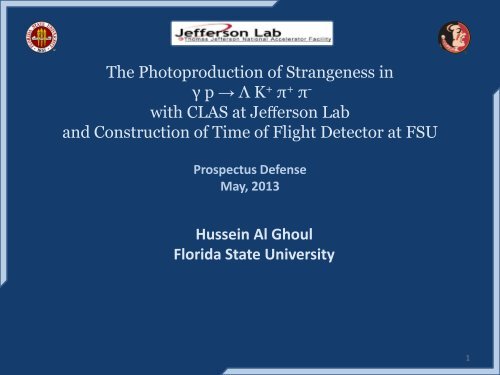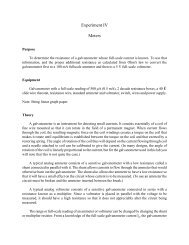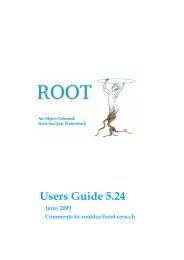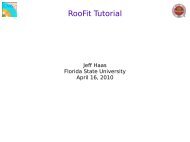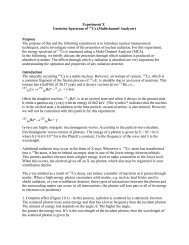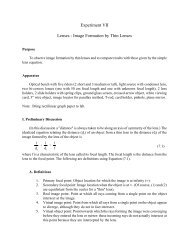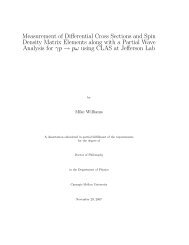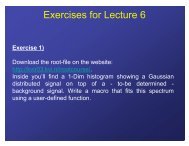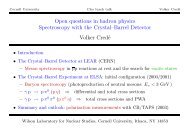CLAS g12 EXPERIMENT
CLAS g12 EXPERIMENT
CLAS g12 EXPERIMENT
You also want an ePaper? Increase the reach of your titles
YUMPU automatically turns print PDFs into web optimized ePapers that Google loves.
The Photoproduction of Strangeness in<br />
γ p → Λ K + π + π -<br />
with <strong>CLAS</strong> at Jefferson Lab<br />
and Construction of Time of Flight Detector at FSU<br />
Prospectus Defense<br />
May, 2013<br />
Hussein Al Ghoul<br />
Florida State University<br />
1
Objectives<br />
‣ INTRODUCTION<br />
‣ MOTIVATION<br />
‣ <strong>CLAS</strong> <strong>g12</strong> <strong>EXPERIMENT</strong><br />
‣ ANALYSIS<br />
‣ GLUEX<br />
Hussein Al Ghoul, Prospectus Defense 2013<br />
2
Objectives<br />
‣ INTRODUCTION<br />
‣ MOTIVATION<br />
‣ <strong>CLAS</strong> <strong>g12</strong> <strong>EXPERIMENT</strong><br />
‣ ANALYSIS<br />
‣ GLUEX<br />
Hussein Al Ghoul, Prospectus Defense 2013<br />
3
Introduction<br />
‣ Quantum Chromodynamics And The Quark Model<br />
‣ Excited Strange Mesons<br />
Hussein Al Ghoul, Prospectus Defense 2013<br />
4
Quantum Chromodynamics And The Quark Model<br />
‣ Quantum Chromodynamics is the theory of strong interactions mediated by<br />
the “color” force.<br />
-Quarks are elementary particles , fermions, that make up all matter. Gluons are exchange<br />
particles, or gauge bosons, for the color force between quarks.<br />
- Baryons are half integer spin particles (fermions), while mesons are integer spin particles<br />
(bosons).<br />
- In the constituent Quark Model, a meson is made up of a quark-antiquark pair. A baryon is<br />
made up of three quarks.<br />
A Meson in the Quark Model<br />
A Baryon as “seen” by QCD<br />
Hussein Al Ghoul, Prospectus Defense 2013<br />
5
Excited Strange Mesons<br />
- Free quarks and gluons haven’t been seen in nature due to the confinement of<br />
quarks.<br />
- Different meson and baryon states are represented according to their total angular<br />
momentum J, the parity P, and the charge conjugation C.<br />
J = L + S<br />
P = (-1) L+1<br />
C = (-1) L+S<br />
allowed J PC = 0 -+ , 0 ++ ,1 -- ,1 +- . . .<br />
- QCD also predicts meson states that are beyond the constituent quark model<br />
(hybrids, glueballs, multi-quark states), these are called “Exotic Mesons”.<br />
exotic J PC = 0 -- , 0 +- ,1 -+ ,2 +- . . .<br />
Hussein Al Ghoul, Prospectus Defense 2013<br />
6
Excited Strange Mesons<br />
‣ In this research, we are looking for excited strange states through<br />
photoproduction. In particular the excited Kaon states.<br />
J PC = 0 - + J PC = 1 - - J PC = 1 - + 7<br />
Hussein Al Ghoul, Prospectus Defense 2013
Objectives<br />
‣ INTRODUCTION<br />
‣ MOTIVATION<br />
‣ <strong>CLAS</strong> <strong>g12</strong> <strong>EXPERIMENT</strong><br />
‣ ANALYSIS<br />
‣ GLUEX<br />
Hussein Al Ghoul, Prospectus Defense 2013<br />
8
Motivation<br />
‣ The γ p → p K + π + π - [π - ] reaction is an opportunity for searching for excited<br />
strange mesons.<br />
- Understand the photoproduction of a strange meson off a Λ strange baryon.<br />
- Preliminary results predict two decaying modes in the (K + π + π - ) system , that will be presented later<br />
on in this talk.<br />
Hussein Al Ghoul, Prospectus Defense 2013<br />
9
Objectives<br />
‣ INTRODUCTION<br />
‣ MOTIVATION<br />
‣ <strong>CLAS</strong> <strong>g12</strong> <strong>EXPERIMENT</strong><br />
‣ ANALYSIS<br />
‣ GLUEX<br />
Hussein Al Ghoul, Prospectus Defense 2013<br />
10
<strong>CLAS</strong> <strong>g12</strong> <strong>EXPERIMENT</strong><br />
- Jefferson Lab hosts CEBAF (Continuous Electron Beam Accelerator Facility) that<br />
delivers up to a 5.5 GeV photon beam to three halls: A, B and C.<br />
- Hall B hosts the CEBAF Large Acceptance Spectrometer (<strong>CLAS</strong>).<br />
Layout of CEBAF<br />
Layout of <strong>CLAS</strong><br />
Hussein Al Ghoul, Prospectus Defense 2013<br />
11
<strong>CLAS</strong> <strong>g12</strong> <strong>EXPERIMENT</strong><br />
- The <strong>g12</strong> experiment was primarily approved for exotic mesons and excited<br />
cascade states studies.<br />
- Up to a 5.5 GeV photon beam incident on a LH 2 target.<br />
- 26.2 billion triggers (68 Pb -1 , 126 TB) of various topologies.<br />
- About 25M γp → p K + π + π - [π - ] events.<br />
Hussein Al Ghoul, Prospectus Defense 2013<br />
12
Objectives<br />
‣ INTRODUCTION<br />
‣ MOTIVATION<br />
‣ <strong>CLAS</strong> <strong>g12</strong> <strong>EXPERIMENT</strong><br />
‣ ANALYSIS<br />
‣ GLUEX<br />
Hussein Al Ghoul, Prospectus Defense 2013<br />
13
ANALYSIS<br />
- The γp → p K + π + π - [π - ] events are selected from all the available data files.<br />
- About 24M γp → p K + π + π - [π - ] events.<br />
Description<br />
Events<br />
Selected from Data Files 24461620<br />
Timing and Vertex 4623235<br />
Beam Energy: E γ > 4.4 GeV 2045110<br />
Fitted Events 1176693<br />
5% Confidence Level Cut 397077<br />
Beta: P K < 1.85 GeV/c 186158<br />
Λ Selection 71488<br />
|t’|< 0.5 Gev 2 14980<br />
Hussein Al Ghoul, Prospectus Defense 2013<br />
14
Missing Pion Selection<br />
-Corrections applied in this part include: beam energy loss, particle energy loss and momentum corrections.<br />
Hussein Al Ghoul, Prospectus Defense 2013<br />
15
Selection of the Missing Pion and Kinematic Fitting<br />
- The missing mass is fit to a pion.<br />
- 5% confidence level cut is applied on the data.<br />
π - K -<br />
Hussein Al Ghoul, Prospectus Defense 2013<br />
16
Beta Cut<br />
Beta is the velocity of the particle.<br />
β = P/E<br />
Hussein Al Ghoul, Prospectus Defense 2013<br />
17
Selection of Λ<br />
Hussein Al Ghoul, Prospectus Defense 2013<br />
18
Intermediate States in the (K + π + π - ) System<br />
K*<br />
ρ<br />
K s<br />
K*(1410)?<br />
Hussein Al Ghoul, Prospectus Defense 2013<br />
19
Reduction of Baryon Background with t’ Cut<br />
Select events of t’ < 0.5 GeV 2 / c 4<br />
Σ(1385)<br />
Hussein Al Ghoul, Prospectus Defense 2013<br />
20
(K + π + π - ) System Study<br />
Hussein Al Ghoul, Prospectus Defense 2013<br />
21
What’s next?<br />
- Understand the baryon background and possibly including it in PWA.<br />
- Determine the cross section of (Λ K + π + π - ) and its upper limit.<br />
- A total of 15K Events were finally Selected, ready for PWA.<br />
Partial wave analysis of the (K + π + π - ) System will use decay amplitudes A α (τ)<br />
to study the contribution of various spin-parity states.<br />
Hussein Al Ghoul, Prospectus Defense 2013<br />
22
Objectives<br />
‣ INTRODUCTION<br />
‣ MOTIVATION<br />
‣ <strong>CLAS</strong> <strong>g12</strong> <strong>EXPERIMENT</strong><br />
‣ ANALYSIS<br />
‣ GlueX Experiment<br />
Hussein Al Ghoul, Prospectus Defense 2013<br />
23
GlueX Experiment At Jefferson Lab<br />
- An experiment targeted to search for exotic mesons.<br />
- Detector will be hosted in Hall D at Jefferson Lab, Virginia.<br />
- Expected to start taking data by 2014.<br />
ρ<br />
Fig 19. 12 GeV Upgrade to CEBAF.<br />
Fig 20. The GlueX detector.<br />
Hussein Al Ghoul, Prospectus Defense 2013<br />
24
Time of Flight (TOF) Detector<br />
- The GlueX detector is made of 6 sections: Superconducting<br />
solenoid, Start Counter, Barrel Calorimeter (BCAL), Central Drift<br />
Chamber (CDC), Forward Drift Chamber (FDC), and the Time of<br />
Flight (TOF), detector.<br />
- The time of flight detector is important for particles<br />
identification.<br />
- The Time of Flight section will be built here at FSU.<br />
- Consists of two planes of scintillator paddles each of which<br />
consists 44 bars per plane.<br />
- Each paddle is 2.5 m long, 6 cm wide, and 2.5 cm thick<br />
and is mounted by photomultipliers on opposite sides.<br />
- Scintillators and photomultipliers were tested.<br />
- Prototype modules were made.<br />
- A prototype was constructed.<br />
Fig 21. The TOF detector.<br />
Hussein Al Ghoul, Prospectus Defense 2013<br />
25
Conclusion and Future Plans<br />
- The chosen channel has shown to be convenient for studying the<br />
photoproduction of strange mesons.<br />
- All data files have been processed and all corrections were<br />
performed.<br />
- The final decay modes of the (K + π + π - ) system are expected to be the<br />
(K * π + ) and the (ρ K + ).<br />
- Partial Wave Analysis will start shortly.<br />
- Study the Cross Section of the (Λ K + π + π - ) System.<br />
- Construct the final TOF modules.<br />
Hussein Al Ghoul, Prospectus Defense 2013<br />
26
Thank You!<br />
Hussein Al Ghoul, Prospectus Defense 2013<br />
27


